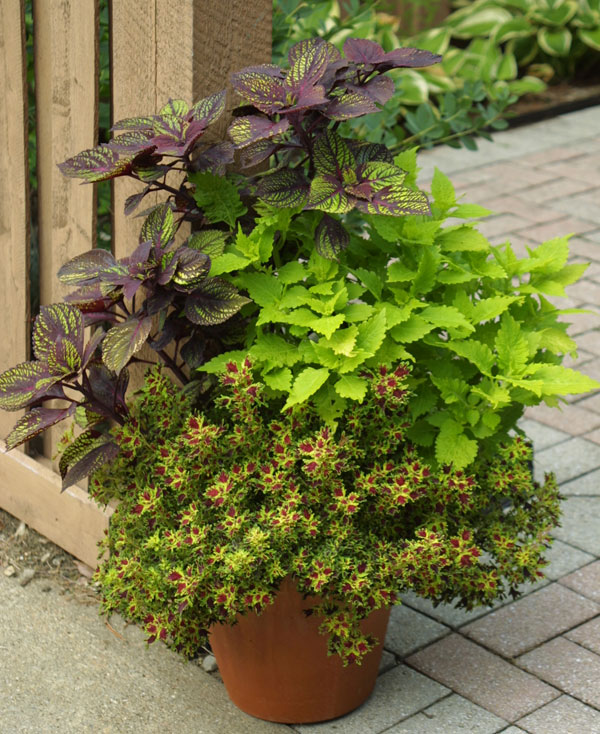
Those who have yet to discover coleus (Solenostemon scutellarioides cvs., USDA Hardiness Zone 11) are missing out on the stupefying number of possibilities they offer. Whether grown in containers or in the ground, used as specimen plants or as partners in a combination, these multicolored beauties perform like nothing else in the garden. Don’t let their beguiling colors prevent you from taking advantage of their other design attributes: Coleus come in different shapes and sizes from trailing varieties to big bushy mounds. From vibrant splashes of color to flowing curves of texture, look no further for the secret ingredient to complete your garden masterpiece.
The following examples demonstrate several ways to use coleus. Any number of plant combinations, however, can be created with their kaleidoscope of colors and other elements. Use the basic principles of each technique to form your own designs, or follow the examples given here.
More on coleus
Video: Pinching Coleus
Article: Sizing Up Coleus
1. Use it as an alluring focal point
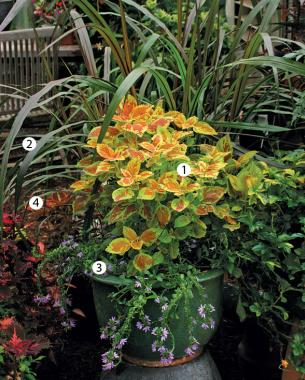
Simply put, a focal point is an element in a composition (such as a painting or a garden area) that draws attention to itself and the area around it. It can lead your eye to a distant point and make a garden seem larger, or it can divert your attention away from an uninteresting or even unattractive feature, such as a plain mass of shrubs or a utility pole. The visual impact of a focal point is magnified when placed against a uniform color or contrasting background.
In this case, the dark, arching blades of purple fountain grass allow the chartreuse and dark orange splashes on the rounded mass of ‘Freckles’ to stand out from the rest of the bunch, creating a focal point. While the hanging clusters of blue fan flower provide an energetic color contrast, there aren’t enough of them to overwhelm the star of the show. An emerald green pot finishes off the look, its dark, even tone fading into the background and letting the plant combo pop.
In this photo
1. ‘Freckles’ coleus
2. ‘Prince’ purple fountain grass (Pennisetum purpureum* ‘Prince’, Zones 8–11)
3. ‘Fancy’ blue fan flower (Scaevola aemula ‘Fancy’, Z 10–11)
4. ‘Flamingo’ coleus
2. Create an eye-elevating topiary
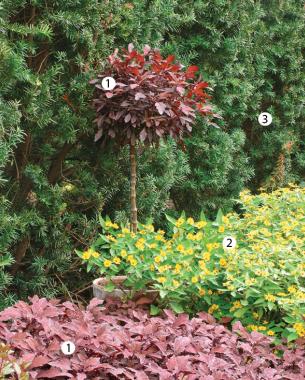
With some specialized attention, a coleus can be easily and quickly trained into a striking topiary. A standard (“ball on a stick”) coleus topiary will lift a planting to a new level of excitement, especially when the same selection mirrors it in the ground or in a potted specimen. Also, keep in mind that a potted plant is often more readily portable—and, therefore, more versatile—than a planted one.
The color, form, and height differences between the mass planting and the assertive, round topiary head of Lancelot Velvet Mocha™ coleus insert an exclamation point into this border. Note how the rich red-brown foliage contrasts with the golden ‘Sunflake Gold’ butter daisy and subtly interacts with the green ‘Hicksii’ yew.
In this photo
1. Lancelot Velvet Mocha™ coleus (Solenostemon scutellarioides ‘UF06-4-18’, Zone 11)
2. ‘Sunflake Gold’ butter daisy (Melampodium paludosum ‘Sunflake Gold’, Z 10–11)
3. ‘Hicksii’ yew (Taxus × media ‘Hicksii’, Z 5–7)
Coleus: Know the basics
They are annuals—sort of. Coleus, considered hardy in Zone 11, are grown as annuals in all other zones. Cultivars can be found for full sun to almost full shade, depending on color and selection.
Soil is not an issue, but drainage is. Coleus grow readily in rich to poor soils—ranging from peaty sand to rocky clay—but prefer moist, well-drained soil. Dry soil will result in wilting. One problem they won’t recover from is root rot, so don’t grow them in poorly drained areas.
Steady watering and feeding are best. Coleus require average amounts of water. A thirsty coleus will wilt dramatically in dry soil and low humidity, but it will recover quickly after being watered. Although they will get by with occasional fertilizing, coleus prefer more frequent mealtimes and will reward you with bigger, lusher plants.
They like a good pinch. Many coleus benefit from attentive removal of their flower spikes (and a set or two of the leaves below them) before they elongate and bloom. Pinching encourages branching and denser growth for a fuller, less spindly plant. It also conserves energy for foliage you want, not spikes and stragglers you don’t want. Scissors, pruners, and your own thumb and index finger all work quite well. You can, however, stop pinching a month or so before your normal frost date: You deserve a rest after your diligence, and some selections (such as ‘Sedona’ and ‘Odalisque’) might surprise you with their cheerful, bright blue flowers.
3. Echo other elements in a combination
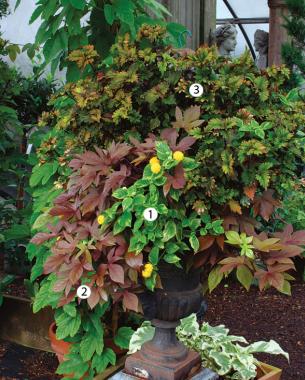
A coleus doesn’t always demand the starring role in a composition. Sometimes, like a good supporting character, it echoes the colors and other elements in a combination, helping tie everything together. Let the colors of a coleus play off of the same colors in other plants, and don’t forget to employ line, form, and texture as supporting elements.
Although relatively small, the bright yellow flower clusters and variegated foliage of ‘Samantha’ lantana jump out as the focal point. The bold, pointy leaves of the trailing ‘Sweet Caroline Bronze’ sweet potato vine add another attention-getting feature without distracting from the lantana. Now, look closely at the exuberant ‘Smallwood’s Driveway’ coleus: Its mass of foliage repeats the yellow and green of the lantana as well as the bronze and chartreuse of the sweet potato vine, subtly unifying the entire planting.
In this photo
1. ‘Samantha’ lantana (Lantana camara* ‘Samantha’, Zone 11)
2. ‘Sweet Caroline Bronze’ sweet potato vine (Ipomoea batatas ‘Sweet Caroline Bronze’, Z 11)
3. ‘Smallwood’s Driveway’ coleus
4. Contrast and connect with other plants
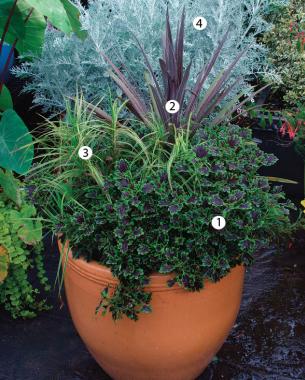
Color usually makes the first impression and often dominates in a composition, but don’t forget the importance of its interplay with line, form, and texture. Line leads the eye from one area to another and ties a planting together—for instance, when a plant seems to explode upward and outward, drawing the eye in those directions. Form gives a sense of placement in space and can also suggest feeling, like the strength of a triangular shape or the comfort of a smooth, rounded sphere. Texture is the perception of coarseness or fineness and the variation in both dimension and tactile feeling. Big plants with a few big spaces between them appear coarse, whereas smaller, more linear parts, like those of a fern, denote a fine texture. Coleus abundantly provide all four design elements and so make excellent choices for memorable container plantings.
In this planting, note how the almost-black centers of ‘Inky Fingers’ pick up on the dark tones of ‘Red Sensation’ cordyline, while the green edges of the coleus echo the variegated palm sedge. The gently curving mass of coarser coleus contrasts sharply with its distinctively linear, more open, finer companions, and the entire mass of plants stands out against the solidly colored orange pot and the ‘Colchester White’ dusty miller in the background.
In this photo
1. ‘Inky Fingers’ coleus
2. ‘Red Sensation’ cordyline (Cordyline australis ‘Red Sensation’, Zones 10–11)
3. ‘Oehme’ variegated palm sedge (Carex muskingumensis ‘Oehme’, Z 3–8)
4. ‘Colchester White’ dusty miller (Centaurea cineraria ‘Colchester White’, Z 7–11)



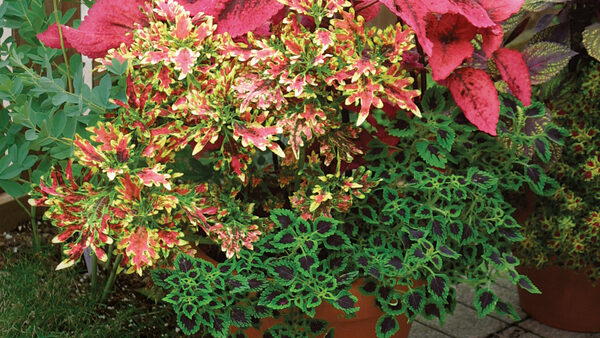
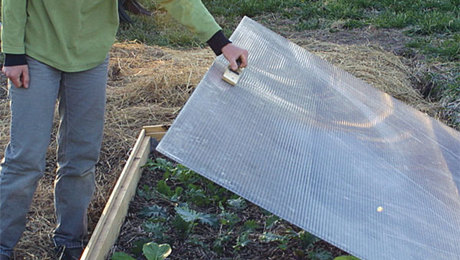












Comments
I am in Panama, from CA.. Artistically, I make plant/driftwood/moss combinations For years I have used Tillandsias . I have discovered here that orchids will also grow in/on driftwood with small or no 'pot', or soil. Also some fern like plants. I wonder about the coleus. Would it survive in no soil, or very little? Or in a moss bed? Any arguments for or against the survivability chances would be welcome and appreciated. ty.
Log in or create an account to post a comment.
Sign up Log in